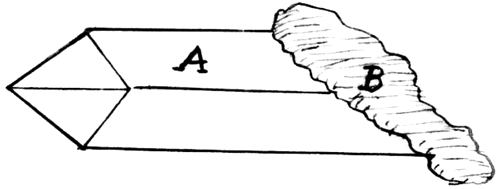George N. Ralls to Thomas Jefferson, 2 April 1815
From George N. Ralls
Washington Culpeper Va 2nd April 1815.
Dear sir
Can I flatter myself you,ll have the goodness to pardon the liberty I have thus taken? Altho I have not the pleasure of your acquaintance still your love of natural history, and the progress you have made, in this most interesting science, is not unknown to me. Finding no mention made in your “Notes on Virginia,” of a certain discription of Flint Stones found in various parts of the state, and being very anxious to have your opinion respecting their formation &ca1 I have been induced to request you,ll gratify me the first oportunity which your convenience may point out.—The Stones I make no doubt have excited your attention, they are generally composed of the most transparent flint, and have to every appearance once passed thro the hands of some skillful lapidist, the one I have now before me is cut in part, beautifully smooth, is of a hexigon figure. A.—The part B is rough and unpolished, to break them I dont discover any thing like a continuation, or layers of the same regularity, or smoothness within, which I think, would be the case if they were the works of nature.—

But how to account for their use, or, for the great variety in figure, as well as size (no two being alike, or of the same dimensions) is beyonnd my reach—
I trust sir, you,ll pardon me, and have the goodness to let me have the pleasure of hearing from you very shortly—Wishing you every possible happiness,
I am dear sir,
Geo: N: Ralls.
RC (ViW: TC-JP); at foot of text: “Thomas Jefferson Esqr Monticello Va”; endorsed by TJ as a letter from “Ralls, or Kalls, Geo. N.” received 8 May 1815 and so recorded in SJL.
George N. Ralls (d. 1822) was a native of Alexandria. He served as secretary of the city’s Masonic lodge, 1812–13. Ralls moved to Culpeper County in about 1814, and he was soundly defeated in the 1820 election to represent that county in the Virginia House of Delegates. At the time of his death he was the vice commercial agent for the United States at Havana (Alexandria Gazette, Commercial and Political, 30 Dec. 1812, 25 May 1813; Franklin L. Brockett, The Lodge of Washington. A History of the Alexandria Washington Lodge, No. 22, A. F. and A. M. of Alexandria, Va., 1783–1876 [1876], 32–3; Vi: RG 48, Personal Property Tax Returns, Culpeper Co., 1814–20; Fredericksburg Virginia Herald, 22 Apr. 1820; Washington Daily National Intelligencer, 16 July 1822).
The flint stones were probably crystals of quartz (silicon dioxide), which often appear as colorless, hexagonal prisms (Gustav B. Baetcke, Identification Guide to Common Minerals and Rocks of Virginia [1961], 17, 25, 47).
1. Preceding four words interlined.
Index Entries
- Jefferson, Thomas; Writings; Notes on the State of Virginia search
- mineralogy; of Va. search
- Notes on the State of Virginia (Thomas Jefferson); consulted search
- Ralls, George N.; identified search
- Ralls, George N.; inquires about Va. minerals search
- Ralls, George N.; letter from search
- Virginia; minerals of search

![University of Virginia Press [link will open in a new window] University of Virginia Press](/lib/media/rotunda-white-on-blue.png)
